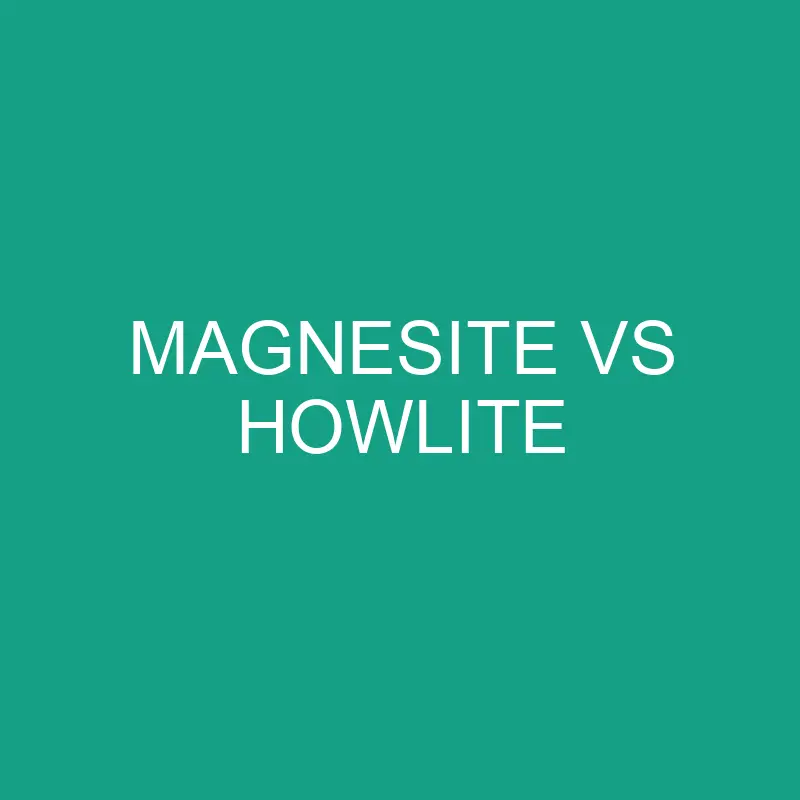Unveiling the Calming Charms of White Gemstones
In the realm of gemstones, the allure of white stones is unmistakable. Magnesite and Howlite, both often presenting in serene shades of white, are two such gems that captivate with their simplicity and elegance. In this comparative exploration, we will delve into the distinct features, geological origins, and metaphysical properties of Magnesite and Howlite, unraveling the calming charms that these white gemstones bring to the world of jewelry and holistic practices.
Post Contents
Magnesite: The Ivory Gem of Tranquility
Origins and Geological Background:
- Composition: Magnesite is a carbonate mineral composed of magnesium, carbon, and oxygen.
- Color: It typically appears in shades of white, ivory, or gray, occasionally displaying streaks or patterns.
- Formation: Magnesite forms through the alteration of magnesium-rich rocks in sedimentary and low-temperature hydrothermal environments.
Physical Properties:
- Color and Appearance: White to ivory, often with a glassy or pearly luster.
- Transparency: Magnesite is typically translucent to opaque.
- Crystal Structure: It crystallizes in the trigonal crystal system.
- Hardness: Magnesite has a hardness of 3.5-4.5 on the Mohs scale.
Origins and Mining:
- Locations: Magnesite is found in various locations globally, including Austria, China, Greece, and the United States.
- Mining: Extracted through traditional mining methods, Magnesite is valued for its use in various industrial applications and as a gemstone.
Metaphysical Properties:
- Calming Energies: Magnesite is associated with calming energies, making it a popular choice for those seeking emotional balance and relaxation.
- Enhancing Visualization: It is believed to enhance visualization during meditation and promote a positive outlook.
Uses in Jewelry and Art:
- Jewelry: Magnesite is used in a variety of jewelry pieces, including beads, cabochons, and pendants.
- Carvings and Sculptures: Its relative softness allows for intricate carvings and sculptures.
Howlite: The White Marble of Simplicity
Origins and Geological Background:
- Composition: Howlite is a borate mineral composed of calcium, boron, silicon, oxygen, hydrogen, and carbon.
- Color: Naturally, Howlite is white or colorless, often with gray to black veins or streaks, resembling white marble.
- Formation: It is formed in boron-rich evaporite deposits and occurs as nodules within sedimentary rocks.
Physical Properties:
- Color and Appearance: White with gray to black veins, mimicking the appearance of white marble.
- Transparency: Howlite is typically opaque.
- Crystal Structure: It crystallizes in the monoclinic crystal system.
- Hardness: Howlite has a hardness of 3.5 on the Mohs scale.
Origins and Mining:
- Locations: Howlite is primarily found in Canada, especially in Nova Scotia, as well as parts of the United States.
- Mining: Extracted through traditional mining methods, Howlite is utilized both as a gemstone and for ornamental purposes.
Metaphysical Properties:
- Calming and Patience: Howlite is associated with calming energies, aiding in reducing stress and promoting patience.
- Enhancing Communication: It is believed to enhance communication and facilitate a better understanding of oneself.
Uses in Jewelry and Art:
- Jewelry: Howlite is popular in jewelry, especially in beads, cabochons, and as accents in various designs.
- Carvings and Decorative Items: Its marble-like appearance makes Howlite suitable for carvings, decorative items, and sculptures.
Comparative Analysis: Magnesite vs. Howlite
Color and Appearance:
- Magnesite: White to ivory, often with a glassy or pearly luster.
- Howlite: White with gray to black veins, resembling white marble.
Transparency:
- Magnesite: Typically translucent to opaque.
- Howlite: Usually opaque.
Crystal Structure:
- Magnesite: Trigonal crystal system.
- Howlite: Monoclinic crystal system.
Hardness (Mohs Scale):
- Magnesite: 3.5-4.5.
- Howlite: 3.5.
Origins and Mining:
- Magnesite: Found in various locations, including Austria, China, Greece, and the United States.
- Howlite: Primarily found in Canada, especially in Nova Scotia, and parts of the United States.
Metaphysical Properties:
- Magnesite: Associated with calming energies and enhancing visualization.
- Howlite: Associated with calming energies, patience, and improved communication.
Uses in Jewelry and Art:
- Magnesite: Used in a variety of jewelry pieces, including beads, cabochons, and pendants, as well as carvings and sculptures.
- Howlite: Popular in jewelry, especially in beads, cabochons, and as decorative elements, as well as carvings and sculptures.
Conclusion: Choosing Between Magnesite and Howlite
Magnesite and Howlite, with their calming energies and elegant appearances, offer individuals a choice of white gemstones that extend beyond conventional aesthetics. Magnesite, with its ivory tones and soothing energies, is often chosen by those seeking emotional balance and a sense of calm. It is versatile, finding its place in various jewelry designs and artistic creations.
Howlite, with its distinctive marble-like appearance, exudes simplicity and elegance. Beyond its aesthetic charm, Howlite is associated with reducing stress, enhancing patience, and facilitating improved communication. Its use in jewelry, both as a standalone gem and in combination with other stones, showcases its versatility and appeal.
Choosing between Magnesite and Howlite may come down to personal preferences, whether one is drawn to the pearly luster of Magnesite or the marble-like veins of Howlite. Both stones invite wearers to embrace their calming energies, making them not just adornments but also companions on a journey towards tranquility and balance. Whether worn as a pendant close to the heart or crafted into a unique sculpture, Magnesite and Howlite add a touch of serenity to the world of gemstone enthusiasts.
